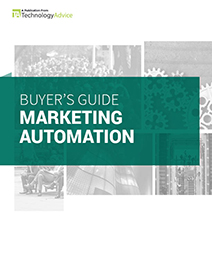Megan Tonzi is the director of marketing at QuotaFactory. She is responsible for creating valuable content for sales and marketing professionals, overseeing the Sales Wars blog, and collaborating with industry thought leaders on co-marketing initiatives. She also helps bridge the gap between the sales and marketing processes by taking on sales enablement responsibilities. Connect with her on Twitter and LinkedIn.
If you dropped a Rolodex on the desk of a young sales rep today, they’d have no idea what to do with it. If you told the rep to expand their territory, would you expect them to go out and canvas a new neighborhood? Of course not. We have tools and platforms and processes in place to automate these tasks — to pull in data from infinite sources and turn out actionable business intelligence.
Thanks to modern sales and marketing technology, the way companies market and sell is changing, and for the most part, growing more homogenous. Marketo has found that companies with an aligned sales and marketing strategy are 67 percent better at closing deals. In order to stay ahead of the curve and maximize your revenue potential, sales and marketing must work together to take advantage of these advancements in technology.
A few examples:
- Integrated marketing automation/CRM platforms
- Real-time, dynamic reporting
- Web analytics and lead scoring
- Data visualization dashboards
- Sales pipeline management
- Collaboration and project management solutions (e.g. Slack, JIRA, SharePoint)
Strategies and processes are constantly evolving in sales and marketing. While you don’t need to leap headlong into every new tool and best practice, you do need to consider the effect it will/could have on your success rate and your productivity as a business unit. Many of the industry’s recent innovations are working to close the gap between sales and marketing, and that, of course, is a good thing.
Let’s take a look at a few examples.
One Platform Performing Many Functions
At this stage in the game, sales and marketing executives need to focus on finding one, all-encompassing tool to deploy across multiple teams, rather than multiple tools to accomplish individual job functions.
Because of the integrated platform trend (think Salesforce, Infusionsoft, HubSpot), it is becoming more cumbersome for sales reps and marketers to work through an assemblage of tools and technologies that may or may not integrate.
It often takes longer to set up and administer multiple tools, keep data synced, and measure return on investment (ROI). Hence the popularity of the single-solution approach.
For example, prospecting technologies such as QuotaFactory’s PRM (prospect relationship management) encompass dialing technologies, email workflows, email tracking, data aggregation and cleansing capabilities. Most marketing automation tools now include geo tracking, social monitoring, and can even send prospecting emails to sales reps based upon territory. One tool can manage an incredible amount and variety of tasks.
Multiple Departments Working Together Through One Tool
Technology isn’t as segmented as it used to be. Sales and marketing tools often target users in both departments at varying levels within the same organization. Depending on how your tech is “stacked,” this could be a blessing or a curse.
If your teams are poorly aligned, a shared tool will be more stressful than helpful. If your teams are tightly aligned, a shared tool will help users access and share information across departments without switching to their email inbox or using a workaround. This will increase visibility and overall accountability, which leads to increased production (of leads and business opportunities).
When different departments start working together from the same tool, entire business processes can be transformed. At QuotaFactory, for example, sales executives, sales development reps, and marketing team members all receive emails from our marketing automation platform. Sales execs and SDRs get notifications about prospects and leads visiting our website, while marketing manages the workflows, email marketing campaigns, sync issues, and so on.
Choosing the Right Technology for Your Organization
As marketing and sales technology continues to evolve, and as more user groups merge into centralized systems, it will become even more critical to shop smart. This makes each choice a larger purchase decision that should include multiple decision-makers across the organization.
ALSO READ: How B2B Buying Groups Make Decisions
Your team should be conscious of current sales and marketing workflows and how they would like to improve. Find a solution that meets your needs but will also provide new opportunities for growth. Not all systems will play nice with your existing processes, so it’s important to do your homework:
- Clearly define your processes for sales and marketing, as well as any additional departments that will use the same tool(s).
- Don’t build your business process to match the technology capabilities. Find a system that complements your current process.
- Run a demo and ask as many questions as possible (about implementation, pricing, features, integrations, etc.)
*
Finding the right technology to implement across sales and marketing can provide many benefits:
- Better visibility between job functions
- Faster communication and decision-making
- Improved campaigns and sales processes
- Increased response rates and revenue
If anything, err on the side of caution. Not every piece of technology will be useful, necessary, or conducive to your business goals. What are the capabilities of your current tech stack? What capabilities do you need to steer the company in the right direction? What solutions are the best fit?
Top CRM Software Recommendations


